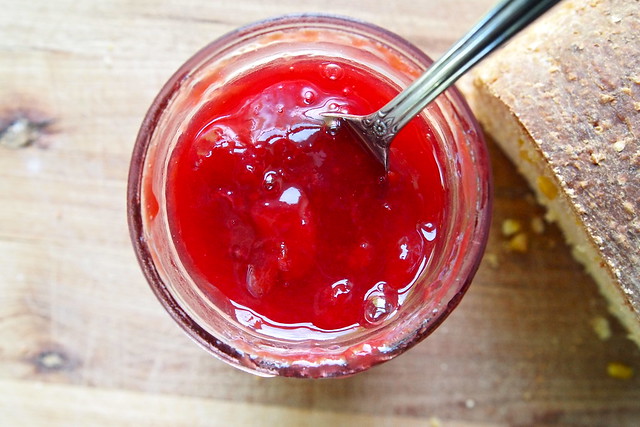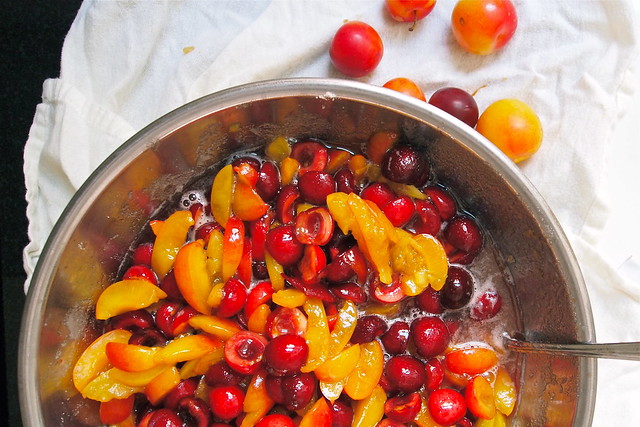I know, I know, another batch of preserves--what gives? I've been asking that of myself a lot lately, and I still don't have much of an answer. I've just found myself this summer making jam feverishly--and not only that but thinking a lot about it (also feverishly)--about what went well and what didn't with past batches, about how to squeeze in another session soon, about what to make next. It's all gotten, I admit, just a little bit obsessive. And before this, if you can believe it, jam wasn't something that really held my interest. Butter, I thought, is all a girl really needs. Why complicate matters?
Why, indeed, complicate matters? That was, for a long time, my attitude towards summer fruit. Berries, peaches, and plums--why fuss with them when they're good as they are? On a sticky July day, you can't do much better for yourself than eating a cold plum over the kitchen sink, juices running down your arms. So why trouble yourself with more? But then twice last week I found myself in the kitchen sweating it out over a pot of bubbling fruit and sugar, glass jars close at hand waiting to be filled. So obviously, at some point, I'd undergone a change of mind.
It had a lot to do with the process, I think. Making preserves is very physical, very absorbing--pulling apart cherries one by one and plucking out their pits or slicing up a mound of plums. You give more attention to the fruit than you might just sticking it in your mouth, and it feels good. And the transformation that takes place, because it happens in an open pan, and because you're there the whole time, stirring, stirring, stirring, is one you get to see all the way through. You get to see the fruit slump and soften. You get to see the sugar disappear into the juices, and the juices bubble up wildly and thicken. It's dramatic and beautiful. You get a different appreciation of the fruit. And you feel like you're tapping into something old, elemental, deeply human.
This, anyway, is the feeling I'm left with, having recently read and swooned over much of Kevin West's Saving the Season. The book is a bit unusual for a cookbook. West provides plenty of clear instruction and assurance on pickles, jams, jellies, and the like. But he also contextualizes preservation as a practice. Between recipes, he draws on a mixture of history, literature, and personal narrative to give us a better sense of the fruits, vegetables, and processes to follow. You get the feeling reading it that you're being given an heirloom, something enduring to hold on to. I'm pretty sure that I'll be turning to the book season after season, year after year, for a long time. (Before the book, West wrote a blog by the same name. I suggest you check on his post on quince, if you want to get the flavour of his work. It's heady.)
This latest batch is from the book, a mixture of early plums and sweet cherries, finished with a splash of bourbon. I didn't make it quite as intended. I was supposed to use inky-dark Bing cherries, but in a moment of absentmindedness at the market, I ended up with a brighter, less assertive variety. So my preserves don't quite have the depth and colour they're supposed to. But I don't really mind. Instead, they have a sort of all-round, stone-fruit sunniness to them, something I know I'll appreciate come January. My favourite spoonfuls are the ones that include a slice of plum. The fruit is velvety, yielding in the best way. And with the bourbon, it is made luxurious, buttery even.
Cherry Preserves with Plums
From Kevin West's Saving the Season
NOTE: Fruit obviously varies in sweetness. The measurements provided for both sugar and lemon juice are therefore guidelines only. West encourages you to taste your fruit at every stage of the process--out of hand, once macerated, and during reduction (after a minute on one of those chilled plates). Adjust with more sugar or lemon juice as you see fit. West also advises starting out with a little less (up to a 1/2 cup less) sugar, depending on the plum varieties available to you. You can always add more sugar towards the end, if you don't think the preserves are sweet enough.
2 pounds black cherries, such as Bing
2 pounds firm, yellow-fleshed plums, such as Red Beauty (the tarter, the better)
2 tablespoons freshly squeezed lemon juice
3 cups sugar
1/4 cup bourbon or brandy
Wash and drain the fruit. Pit the cherries. (West isn't one for cherry-pitters. His method is to grab each cherry, one thumb on either side of the stem, and pull it apart. It should split lengthwise along its seam. Then you can just dig out the pit. This works best, I've found, with soft, ripe cherries. It makes less of a mess than a pitter.) Slice the plums away from their pits in sections. Stir together the fruit, lemon juice, and sugar. Set aside to macerate for at least 15 minutes. (If you plan to macerate for longer, e.g. overnight, press a piece of parchment paper or plastic wrap close to the fruit to prevent oxidation.)
Set a few small plates in the freezer. Warm 5 clean half-pint jars and lids in the oven set at 200 degrees F.
Turn the fruit-sugar mixture into a preserving pan or other large, wide, heavy-bottomed pot. Reduce over high heat, stirring frequently. Once it comes to a full rolling boil, it should take 10-12 more minutes to fully reduce. Test the preserves. Turn off the heat and spoon about a teaspoon's worth onto one of the chilled plates. Return it to the freezer for 1 minute. If the surface wrinkles when you push your finger through it, it's ready. If not, continue reducing for a couple minutes more and test the consistency again. Once fully reduced, add the brandy or bourbon and continue to cook, stirring well, for 1 minute longer.
Ladle the hot preserves into the five half-pint jars, leaving 1/4-inch headspace. Wipe the jars' rims clean and put on their lids and bands (screwed only finger-tight).
Process in a boiling-water bath for 10 minutes (count 10 minutes from when the water returns to a boil). Remove the jars from the water and let cool. Check to see if a proper seal has formed by removing each jar's band and holding the jar by its lid. The lid should hold firm. If it doesn't, store the jar in the fridge and eat its contents promptly.
Makes about 5 1/2-pint jars.
Makes about 5 1/2-pint jars.






I don't mind all the posts about preserves one bit! It's lovely to think about having those jars stored in the pantry come winter. I'll have to check this West gentleman out, as we have a quince tree in the yard that I plan to meddle with later this season.
ReplyDeleteBeautiful photo array up top - love the reds, oranges, yellows all tucked together next to to blue pot. Just fabulous.
And as silly as this sounds, the way you put it got me thinking about what happens when we eat food. It goes into our stomachs, and that's where it gets processed. The fruit, in this case, but really any food. When you make jam, you're right -- all that processing is happening outside the belly, in plain sight. Your post made me think of the whole preserving process in a new way.
Oh, I envy you and your quince tree! I think I'm probably done with summer fruit preserves, but I'd like to try West's quince in honey recipe. I've never actually eaten or cooked quince before, but it seems to be popping up everywhere, and I'm intrigued by it and the transformation it undergoes.
DeleteI canned some jams last summer, but I have to confess I never opened them because I was convinced it couldn't be that simple and I must have screwed something up. That combo of cherries and plums (and bourbon!) looks amazing enough that I may actually try it again!
ReplyDeleteMy grandmother used to can peaches when I was growing up, but other than that, canning is pretty new to me too. In fact, it still is a little crazy to me that my little collection of jams can stay tucked away in the cupboard all year, if I want it to. But between all the acid, sugar, and water-bath processing, jam is pretty effortlessly shelf-stable. Just remember to store your jams without the bands fastened, and if one of the seals is compromised, it'll be easy to tell.
DeleteAh, jam-making. I didn't grow up eating it at all so it's not the first treatment I think of for fresh fruit. Especially when you COULD eat the juicy plum over the sink instead. But I tried jam-making last summer—just a tiny batch of raspberry jam infused with basil—and I get what you mean about watching the transformation occur. It's like the fruit completely changes, from a discrete, whole object into a silky mass. It was pretty fascinating to me.
ReplyDeleteAnd yes, heady post indeed! Again, fascinating though.
Hm, raspberry and basil. I wouldn't have thought of putting those two together! I think I'm done with preserves until the fall, but I'll have to keep the pairing in mind. Raspberry jam is one of my favourites.
DeleteJAM! I tried to make some jam the other day and it turned out a mess. I was using kumquats from our kumquat tree. I'll leave the jam making to my husband's father who has taken up jam making after retiring five years ago!
ReplyDeleteI don't have much experience with citrus and jamming. I'd assume that kumquats would do well treated like other citrus and could be made into a marmalade of some sort. But I'll have to read up on kumquats. They're definitely fun to eat just as they are!
DeleteI still haven't made my own jam but now want to! I also just ate a cold plum - not over a kitchen sink but with plenty of paper towels around me!
ReplyDeleteThese photos are so beautiful and absolutely bursting with color! I never thought I would be much of a jam fiend/fruit preserver either, but I took a class a few years ago with Dafna of Inna Jam and Inna Pickle (good stuff!) and ever since then I've been all about canning. Granted, the dissertation has kept me away from a lot of kitchen experiments this year, but since it will soon be a thing of the past, I'm already looking forward to preserving next summer's bounty. Thanks for the Kevin West tip; I'll definitely check out this book once I return to the US!
ReplyDeleteIn the meantime, happy summer!
Happy summer to you too! I just spotted your post about the butter mochi from Lucky Peach from awhile back. I'm going to have to catch up with your posts! I was surprised last week to find mochiko powder at my local grocery store. I've been considering the butter mochi ever since.
DeleteI love this post. You describe exactly why I love making preserves. I haven't done any this season because I'm choc full from last summer, but I plan to make at least a few batches of apple butter and marmalade this fall. Thanks for the inspiration! Your preserves are gorgeous!
ReplyDelete